Islands
Bartolome Island
| Two views of Pinnacle Rock, Bartolome Island. The more reddish
ground is indicative of oxidation of iron, younger age. |
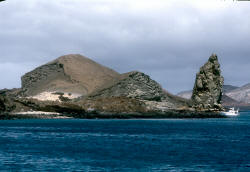
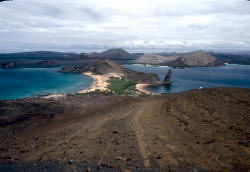
|
| Tiquilia plants on cinder slope looking up to summit of
Bartolome Island. The flowers of the Tiquilia are principal food
items of the endemic lava lizard. |
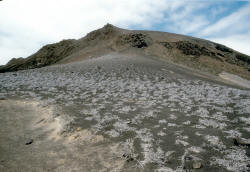
|
The Sea
Algae of the Galapagos: About 333 species occur here (35% of
which are endemic).
Marine Invertebrates of
Galapagos:
Cnidarians:
Anemones: http://www.conservationinstitute.org/anemonebarrens.htm
Corals: 31 species of non-reef building (of which
a third are endemic) and 13 hermatypic. None greatly abundant.
Porites lobata, Pavona clavus, Pavona gigantea Pavona varians,
Psammocora stellata, Diaseris distorta and Cycloseris curvata.
| Pocillopora damicornis and P. elegans are found
in the Galapagos. |
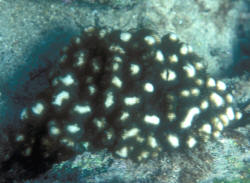
|
Mollusks: About 600 species recorded.
Crustaceans: About 100 species of crabs.
| Grapsus grapsus, the Sally Lightfoot Crab. Galapagos
pix. |
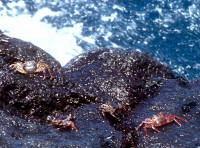 
|
Echinoderms:
Sea Urchins: 24 species recorded.
| Eucidaris thouarsii (Valencinnes 1846), Slate Pencil
Urchin. Family Cidaridae. To 10.2 inches in diameter. Sea of Cortez
to Ecuador and Galapagos Islands. Ten rows of 5-8 variously
sharp/dull club-like spines. Feeds on benthic algae and Pocillopora
and Pavona corals. Common in the Galapagos. Found on rocky shore
shallows to 150 meters depth. Galapagos pic. |

|
| Lytechinus semituberculatus (Agassiz &
Desor 1846), Green Sea Urchin. To 6.4 inches in diameter.
Southeastern Pacific; Columbia to Peru and Galapagos Islands.
Decidedly yellow green in color. Common in rocky shores to 134
meters. Feeds principally on benthic algae. Galapagos pic. |

|
| Tripneustes depressus A. Agassiz 1863, the White Sea
Urchin. To 12.5 inches in diameter. Eastern Pacific; Southern
California to Ecuador and Galapagos Islands. Principally feeds on
coralline algae. Galapagos pix. |

|
Sea Stars: 28 species recorded.
| Nidoriellia armata (Gray 1840), a Chocolate Chip Sea
Star. Family Oreasteridae. To 6.6 inches in diameter. Mid to
Eastern Pacific; Hawaii, Sea of Cortez to Peru and Galapagos. Blunt
arms, large central disc, large aboral spines dark in color.
Variable color and shape. Intertidal to 73 meters, feeds on benthic
marine invertebrates, gastropods and algae. Galapagos pic. |

|
| Pentaceraster cumingi (Gray 1840), the Panamic Cushion
Star. Family Oreasteridae. To 13.4 inches in diameter. Mid to
Eastern Pacific; Hawaii, Sea of Cortez to Peru and Galapagos.
Variably red, orange to greenish blue bodied with large red spines.
Feeds on micro-fauna in substrate, benthic algae, seagrass and
other echinoderms. Usually found on sandy bottoms from shallow to
180 meters depth. Galapagos pics. |


|
| Phataria unifascialis (Gray 1840), the Blue Sea Star. To
7 inches in diameter. Eastern Pacific; Sea of Cortez to Peru and
the Galapagos, rocky shores to 50 meters depth. Dorsal surface blue
or tan with black peppled lines, underside orange. Algae feeder.
Galapagos pic. |
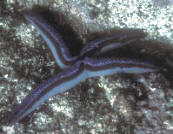
|
Sea Cucumbers: 30 species recorded.
Fishes of the Galapagos: About 400 described
species, 17% endemic.
Eels:
|
Myrichthys maculosus (Cuvier 1816), the Tiger or Spotted
Snake Eel. To a meter in length. Indo-Pacific: Red Sea and East
Africa to the central Pacific, not including Hawaii and the
Leeward Islands. Replaced by Myrichthys magnificus in the
Hawaiian Islands. Lives in and above sandy bottoms, sometimes
exposing itself entirely while hunting for food. Here, out and
about during the day in the Galapagos.
http://www.fishbase.org/Summary/
SpeciesSummary.cfm?ID=2650&genusname=
Myrichthys&speciesname=maculosus
|
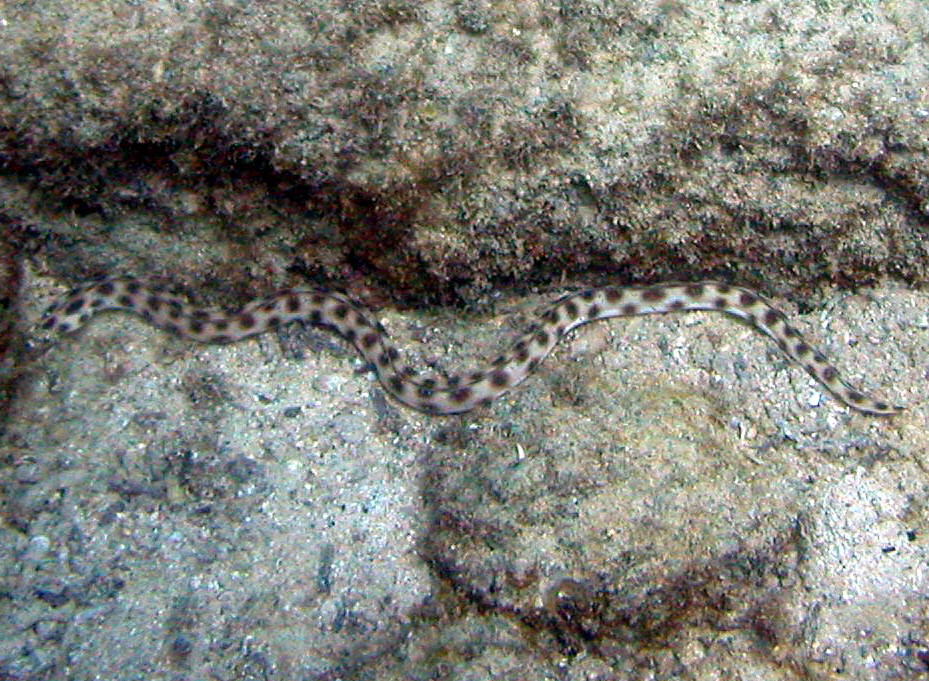
|
| Gymnothorax castaneus (Jordan & Gilbert
1883), the Chestnut Moray (to science) or Morena Verde. To
150 cm. Eastern Pacific; Sea of Cortez to Ecuador, including the
Galapagos, particularly the northern islands of Darwin and Wolf.
Wolf image. |
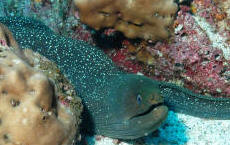
|
Parrotfishes:
| Scarus ghobban Forsskal 1775, the Bluebarred
Parrotfish. Indo-Pacific; Red Sea to Peru... a Lessepsian species,
found in the Mediterranean. To 90 cm. in length. Feed on algae
growing on coral, rock. Pix of initial and terminal stage
individuals in the Galapagos. |
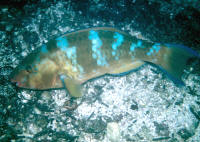 
|
| Scarus rubroviolaceus Bleeker 1847, the
Ember Parrotfish. Indo-pan-Pacific; eastern Africa to Panama,
including Hawaii and Galapagos Islands. To twenty eight inches in
length. Shown, a female and male off Gili Air, Lombok,
Indonesia. |
 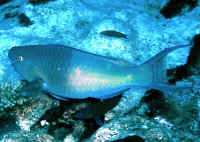
|
Wrasses:
Basses:
| Alphestes immaculatus Breder 1936, the
Pacific Mutton Hamlet. Eastern Pacific; Sea of Cortez to Peru,
including Galapagos. To one foot overall length. This one in the
Galapagos. A beauty. There are five species in this genus. |

|
| Cephalopholis panamensis (Steindachner
1877), the Panamic Graysby, Cabrilla. Eastern Pacific; Sea of
Cortez to Ecuador, Galapagos. To twelve inches in length. A
secretive species. Galapagos pix. |
 
|
| Dermatolepis dermatolepis (Boulenger 1895),
the Leather Grouper. This fish has "made the rounds"
taxonomically, being placed in other genera (more recently
Epinephelus). Tropical eastern Pacific. Cute when small, this
species grows quickly to a large size, to three feet long in the
wild. A tiny individual in a sea urchin, six and twelve inch
individuals in the Galapagos and a two footer in Baja. |
| Liopropoma fasciatum Bussing 1980, the
Banded Bass. Tropical eastern Pacific. To seven inches overall
length. A deepwater, shy species that hangs out in caves. It's
easily trained to stay out in the open in captivity. Aquarium
photo, here at the Birch, SIO. Rarely offered in the trade. |

|
| Mycteroperca olfax (Jenyns
1840), the Bacalao. Recorded from Cocos (Costa Rica) and Galapagos.
To 120 cm. in length. Two foot specimen of Galapagos. |

|
| Serranus psittacinus Valenciennes 1846
(S. fasciatus (Jenyns 1840) is a common synonym. The Barred
Serrano. Eastern Pacific; Sea of Cortez to Chile, including
Galapagos. To seven inches in length. Two four inch ones, in a fish
shop in New Jersey, another at home in the Galapagos! |
 
|
Damsels:
| Abudefduf troschelii (Gill 1862), Panamic
Sergeant. Eastern Pacific; Baja California to Peru and the
Galapagos Islands. To six and a half inches in length. One down at
Mexico's Baja tip, another in the Galapagos. |
 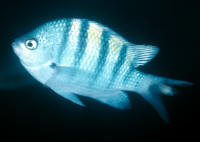
|
| Microspathodon bairdi (Gill 1862), the
Bumphead Damselfish. Tropical eastern Pacific, Baja to Ecuador. To
ten inches in length. This one in Cabo San Lucas, Mexico's Baja
California. |
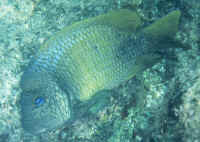
|
| Microspathodon dorsalis (Gill 1862), the
Giant (Mexican) Damselfish. Tropical eastern Pacific, Sea of Cortez
to Ecuador. To ten inches in length. Here are juveniles (1",
3") and an adult (9") in the Mar de Cortez. |
|
Stegastes arcifrons (Heller &
Snodgrass 1903), the Island Major. Good looking and... quite a
bonus, a known Aiptasia eater! To 13 cm. Eastern Pacific: Costa
Rica and from Cocos, Malpelo and Galapagos islands in shallow,
rocky shores. Typical for genus, this is a territorial species
that is constantly looking for, if not driving off members of its
own and often, other fish species. Feeds on algae and small
invertebrates, including tubeworms and anemone tentacles.
Intermediate and adult individuals in the
Galapagos.
http://www.fishbase.org/Summary/SpeciesSummary.cfm?ID=12510&genusname=Stegastes&speciesname=arcifrons
|
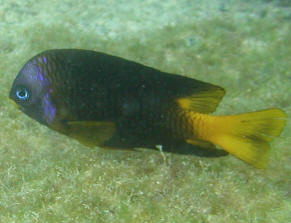
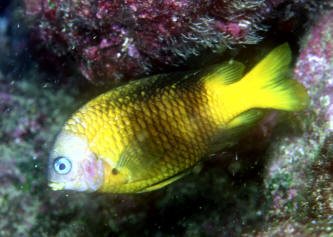
|
Angelfishes (Only one in Galapagos)
|
Holacanthus
passer Valenciennes 1846, the King or Passer Angelfish
(1). Juveniles act as cleaners of other fishes. To about nine
inches in length. A great, hardy fish for a large marine system.
Mid Sea of Cortez on down the Pacific coast to the Galapagos. Two
inch one in Cabo, four inch juvenile in the Galapagos and adult
in Cabo, Mexico.
|
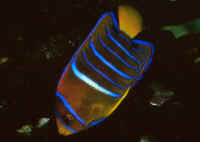
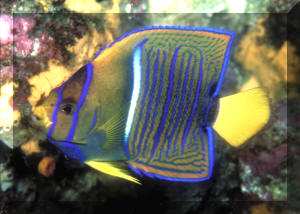

|
Butterflyfishes: Only two are common,
Johnrandallia nigrirostris, at times in large aggregations and
Chaetodon humeralis (mostly in pairs), but a handful of more tropical
mid to eastern Pacific species can be found in the northernmost
Galapagos seasonally... and the Scythe (Prognathodes falcifer) at times
at depth.
| Johnrandallia nigrirostris (Gill 1862), the Blacknosed
Butterflyfish or El Barbero (Barberfish). Sea of Cortez to Ecuador,
including the Galapagos, 10 to 120 feet. To six inches overall
length. A facultative cleaner as juveniles. Pictured here at the
tip of Baja and the Galapagos, the latter where it is most
common. |
 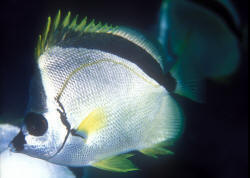 |
Tangs/Doctorfishes: Six species, but principally
Prionurus laticlavius
| Acanthurus
nigricans (Linnaeus 1758) Whitecheek to science, Powder
Brown Surgeonfish to aquarists. Formerly mis-identified as A.
glaucopareius. Pan Pacific. To about eight inches maximum length.
See article on this and the very similar, but more
pet-fish-appropriate A. japonicus. At right in
Nuka Hiva. |
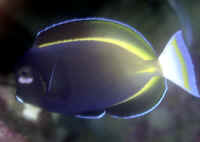
|
The Moorish Idol:
| Zanclus cornutus (Linnaeus 1758), the
Moorish Idol. Indo-Pacific. Can be kept in captivity, though
rarely lives due to trauma in capture, holding, shipping,
starvation during this time, damage to their mouths... Omnivores
that mainly feed on benthic invertebrates. Principally sponges...
and algae. One off of the Galapagos. |
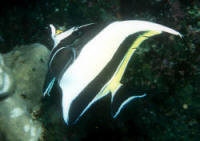
|
Jacks: Mostly large, silvery and just barely in
sight out in the blue, or headed there
| Seriola rivoliana Valenciennes
1833, the Almaco Jack. Circumtropical. Maximum recorded length 160
cm. A juvenile in N. Sulawesi, and a mid-size adult in the
Galapagos. |
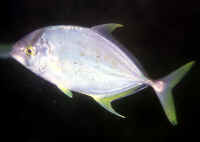

|
Barracudas:
| Sphyraena idiastes Heller & Snodgrass
1903, the Pelican Barracuda. Southeast Pacific; Peru, Galapagos,
Cocos Islands. To 91 cm. Usually found in large groups, oblivious
to divers. Galapagos pic. |
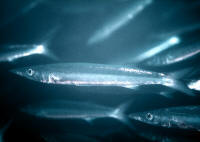
|
Snappers:
|
Lutjanus viridis (Valenciennes 1846), the
Blue and Gold Snapper. Eastern Pacific; Mexico to Ecuador. To one
foot in length. In the Galapagos. Five black lined bluish bars on
body.
|
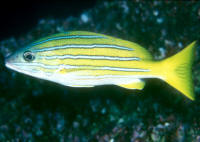
|
Puffers:
|
Arothron hispidus (Linnaeus 1758), the White-Spotted
Puffer. Indo-Pacific, Red Sea, east African coast, tropical east
Pacific coast. To twenty inches in length in the wild.
Photo taken in the Galapagos.
|
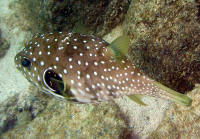
|
Sea Turtles: Mainly the Green (Chelonia
mydas) is encountered, though the Hawksbill (Eretmochelys
imbricata), Leatherback (Dermochelys coriacea) and Olive
Ridley's (Lepidochelys olivacea) occur in the Galapagos.
The Land
Reptiles: Twenty two species in five families including the
marine turtles (Cheloniidae), tortoises (Testudinidae), iguanid lizards
(Iguanidae), Geckos (Gekkonidae), and colubrid snakes (Colubridae).
Twenty endemic species.
Lizards of Galapagos
Iguanas: 3 species: http://www.shunya.net/Pictures/Ecuador/
Galapagos/Iguanas/Iguanas.htm,
http://www.biology-x.com/
biology-x/conolophus-subcristatus.html
Lava Lizards: Genus Tropidurus, seven endemic
species.
| Tropidurus spp. Examples from Santa Cruz and Bartolome
Islands. |
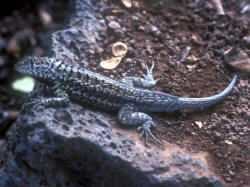 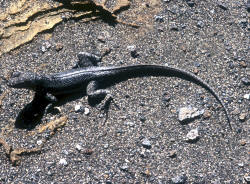
|
Tortoises:
|
All told there are eleven subspecies (one with only one surviving
member...) of the one species, Geochelone elephantopus.
The name "Galapagos" is derived from the name given
these turtles in reference to their "gala pagos" =
Spanish
saddle shaped shells. The various sub-species are
distinguished, differentiated in part by the shape of their
shells. Males are much larger than females... Shown, a low
profile type taking a siesta at mid-day and a female high-shelled
type in the process of digging a nest.
|


|
Birds of Galapagos: Aquatic
| Sheniscus mendiculus, the Galapagos Penguin. To 35 cm.
in height (the third shortest of the eighteen species of penguins
of the world). Only tropical species, nesting north of the equator.
Here by Pinnacle Rock on Bartolome Island, Galapagos. |

|
| Pelecanus occidentalis, the Brown Pelican. Juveniles are
all brown, adults as shown at right. This species occurs widely
around the Americas coasts. One of eight pelican species worldwide,
the Brown is the smallest in size. Galapagos image. |
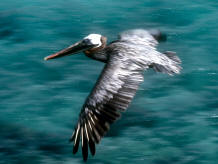
|
| Fregata magnificens, the Magnificient Frigatebird. One
of two species in the Galapagos and of five worldwide. The Frigates
are also called "Man o War Birds" for their pirating
ways. Mainly found in the Caribbean. Pix from Seymour Island,
Galapagos. Male with a young chick on Seymour Island,
Galapagos. |
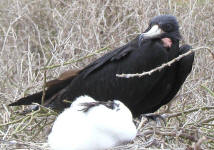
|
| Fregata minor, the Great Frigatebird. Very
similar to the Magnificent Frigate, but females with white only
under chin, and males lack the brown band across the wings and
purplish tinge color on their backs. A female with young and a
displaying male shown on Seymour Island, Galapagos. |
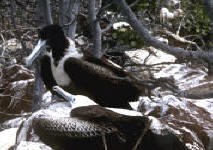
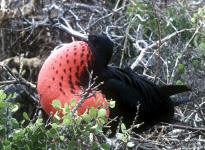
|
Birds of Galapagos: Terrestrial, twenty
nine species, 3/4 endemic, and 14 colonizations
| Geospiza fuliginosa, the Small Ground Finch. One of the
unique subtribe (Geospizini) of Darwin's Finches. 13 species (a
14th occurs on Cocos Island). Noted for their specialized
beaks/diets. Here a female is sitting on a wall at Darwin Station
on Santa Cruz Island. Males of this species are all black in
color. |

|
| Dendroica petechia aureolla, the Yellow Warbler. |
|
Mammals of Galapagos: Pinnipeds (two), dolphins,
whales, a diminishing number of rat species and bats... not including
feral introductions of cats, dogs, burros, non-indigenous
rodents...
| Zalophus californianus wollebacki, the
Galapagos Sea Lion. Males much larger, with a "bump" on
their foreheads. To 250 kg. Galapagos pix of a dry female on land
and a youngster underwater. Brown in color when dry, blackish when
wet. |
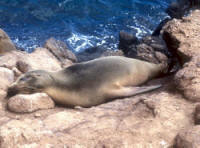
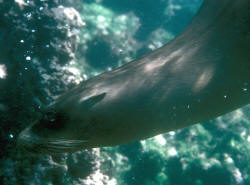
|
Plants of the Galapagos
Cactaceae:
| Jasminocereus thouarsii Candelabra Cactus. To 7 meters
tall. Cylindrical in cross-section that look like organ pipes.
Small flowers (1-2 inches across) are pollinated by night-flying
insects (moths), bearing edible reddish-purple fruits. Three
sub-species occur in the Galapagos. This pic made at Darwin
Station, Puerto Ayora, Santa Cruz Island. |
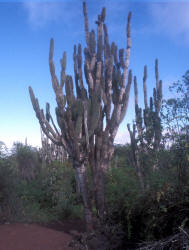
|
| Opuntia echios var. gigantea, one of
the Prickly Pear Cactus. To 12 meters in height. Reddish bark when
older, green and spiny when young. Stems as cactus "pads"
bear spines in groups. Fourteen Opuntia types occur in the
Galapagos. |
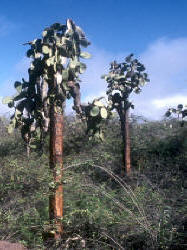
|
| Opuntia sp. Shrubby Prickly Pear Cactus. Another of the
14 species found here (there are more than 300 in N. America).
Important as food for tortoises and land iguanas, the fruit/seeds
and flesh of this genus are used by insects and birds as
nourishment as well. Baltar Island. |
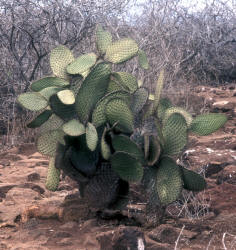
|
Terrestrial Invertebrates:
| Schistocerca melanocera, Painted Locust, Baltar Island,
Galapagos. |

|
Bibliography/Further Information:
Galapagos Conservation Trust: http://www.gct.org/
Galapagos Darwin Foundation: https://www.galapagos.org
Aquarium Fishes of the Galapagos: http://members.tripod.com/mark26/galapogos.html
Hickman, Cleveland P. 1998. A Field Guide to Sea Stars and other
Echinoderms of Galapagos. Sugar Springs Press, VA. 83 pp.
Humann, Paul and Ned DeLoach. 1993. Reef Fish Identification,
Galapagos. New World Publications, Fla. 226 pp.
Jackson, Michael H. 1993 (2002 printing). Galapagos, A Natural
History. Univ. of Calgary Press. 316 pp.
| Galapagos, Volker + Christina Hi Bob ( uncle
Bob ) , hi Diana, <Hey Volker and Christine, how are you?>
many greetings from gold old Hamburg, Germany !! How are you?
<Fine my friends> It was a great pleasure to meet you.
<And you> We just arrived yesterday and we have enjoyed our
time at Galapagos. At our first dive last Thursday
Christina met a lot of hammersharks, I did not ... There
is a picture attached. <Very nice> And you? Were are you
staying now? Next trip planed? <We're back home in San
Diego, am out to Hawaii next week, Di's coming out there toward
the end of the month, then I'm off to the east coast (Boston)
in Sept. to give a talk, then we're going to Negril/Jamaica or
Bonaire to visit/dive for Di's birthday...> And the picture
with all of us is also attached. <Thank you> You want more
underwater pictures? See lions, Turtles, Mur?en ( don't
now it in English ), white tipped sharks, rays, etc ...
<If they're in focus, please> May be you both will answer
... See you in Hawaii!! Volker + Christina <Looking forward to
it. The link showing a bit about the place there: http://www.wetwebmedia.com/holualoaproperty.htm
Bob Fenner> |
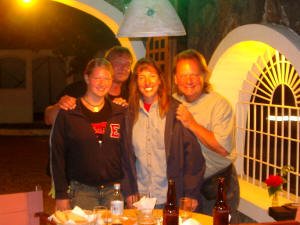 |
 |
|
|

